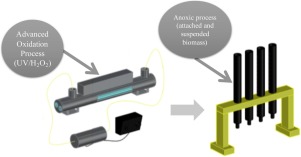当前位置:
X-MOL 学术
›
Process Saf. Environ. Prot.
›
论文详情
Our official English website, www.x-mol.net, welcomes your feedback! (Note: you will need to create a separate account there.)
Using sequentially coupled UV/H2O2-biologic systems to treat industrial wastewater with high carbon and nitrogen contents
Process Safety and Environmental Protection ( IF 7.8 ) Pub Date : 2020-05-01 , DOI: 10.1016/j.psep.2020.02.020 A.D. Ortiz-Marin , L.E. Amabilis-Sosa , E.R. Bandala , R.A. Guillén-Garcés , L.G. Treviño-Quintanilla , A. Roé-Sosa , G.E. Moeller-Chávez
Process Safety and Environmental Protection ( IF 7.8 ) Pub Date : 2020-05-01 , DOI: 10.1016/j.psep.2020.02.020 A.D. Ortiz-Marin , L.E. Amabilis-Sosa , E.R. Bandala , R.A. Guillén-Garcés , L.G. Treviño-Quintanilla , A. Roé-Sosa , G.E. Moeller-Chávez

|
Abstract This study evaluated the performance of a sequentially coupled UV/H2O2-anoxic system to treat industrial wastewater (IWW). Initial IWW characterization showed a high chemical oxygen demand (COD) load (13,261 mg L−1, 6,880 mg L−1 of total organic carbon (TOC), 569 mg L−1 of total nitrogen (TN), and an alkaline pH (9.1 ± 1.51). Using advanced oxidation processes (AOPs), removal efficiencies of 49.4 % of COD and 85 % of total organic carbon (TOC) were achieved after 60 min of UV-C irradiation (82 W m−2) using a H2O2/COD ratio of 0.78:1. Under these conditions, a 50 % transformation of TN into nitrites and nitrates (NO2+NO3)-N was also observed. After the AOP, the partially treated IWW was mixed with municipal wastewater (MWW) at ratio of 1:10, based on toxicity test results, and then used as the influent of the biological process. The biological process consisted of anoxic suspended and attached biomass coupled sequentially after the UV/H2O2 system. Both biological systems (attached and suspended biomass reactors) efficiently removed (NO2+NO3)-N, achieving 85 % removal of TN, 41.8 % removal of TOC, and 49.2 % removal of COD and denitrification process was found to occur after the AOP through the biological systems. In addition, pH values ranging from 6 to 7.6 were observed after the biological treatment, which suggests that the resulting effluent could be treated using conventional water treatment.
中文翻译:

使用顺序耦合的 UV/H2O2-生物系统处理高碳和氮含量的工业废水
摘要 本研究评估了连续耦合 UV/H2O2-缺氧系统处理工业废水 (IWW) 的性能。初始 IWW 表征显示高化学需氧量 (COD) 负荷(13,261 mg L-1、6,880 mg L-1 总有机碳 (TOC)、569 mg L-1 总氮 (TN) 和碱性 pH( 9.1 ± 1.51). 使用高级氧化工艺 (AOP),在使用 H2O2 的 UV-C 照射 (82 W m-2) 60 分钟后,COD 的去除效率为 49.4 %,总有机碳 (TOC) 的去除效率为 85 % /COD 比为 0.78:1。在这些条件下,还观察到 50% 的 TN 转化为亚硝酸盐和硝酸盐 (NO2+NO3)-N。在 AOP 之后,部分处理的 IWW 与市政废水 (MWW) 混合在1:10 的比例,根据毒性测试结果,然后用作生物过程的进水。生物过程包括在 UV/H2O2 系统之后依次耦合的缺氧悬浮和附着的生物质。两种生物系统(连接式和悬浮式生物质反应器)都有效去除了 (NO2+NO3)-N,实现了 85% 的 TN 去除、41.8% 的 TOC 去除和 49.2% 的 COD 去除和反硝化过程被发现在 AOP 之后发生生物系统。此外,在生物处理后观察到的 pH 值范围为 6 至 7.6,这表明可以使用常规水处理处理产生的污水。发现通过生物系统在 AOP 之后发生了 2% 的 COD 去除和反硝化过程。此外,在生物处理后观察到的 pH 值范围为 6 至 7.6,这表明可以使用常规水处理处理产生的污水。发现通过生物系统在 AOP 之后发生了 2% 的 COD 去除和反硝化过程。此外,在生物处理后观察到的 pH 值范围为 6 至 7.6,这表明可以使用常规水处理处理产生的污水。
更新日期:2020-05-01
中文翻译:

使用顺序耦合的 UV/H2O2-生物系统处理高碳和氮含量的工业废水
摘要 本研究评估了连续耦合 UV/H2O2-缺氧系统处理工业废水 (IWW) 的性能。初始 IWW 表征显示高化学需氧量 (COD) 负荷(13,261 mg L-1、6,880 mg L-1 总有机碳 (TOC)、569 mg L-1 总氮 (TN) 和碱性 pH( 9.1 ± 1.51). 使用高级氧化工艺 (AOP),在使用 H2O2 的 UV-C 照射 (82 W m-2) 60 分钟后,COD 的去除效率为 49.4 %,总有机碳 (TOC) 的去除效率为 85 % /COD 比为 0.78:1。在这些条件下,还观察到 50% 的 TN 转化为亚硝酸盐和硝酸盐 (NO2+NO3)-N。在 AOP 之后,部分处理的 IWW 与市政废水 (MWW) 混合在1:10 的比例,根据毒性测试结果,然后用作生物过程的进水。生物过程包括在 UV/H2O2 系统之后依次耦合的缺氧悬浮和附着的生物质。两种生物系统(连接式和悬浮式生物质反应器)都有效去除了 (NO2+NO3)-N,实现了 85% 的 TN 去除、41.8% 的 TOC 去除和 49.2% 的 COD 去除和反硝化过程被发现在 AOP 之后发生生物系统。此外,在生物处理后观察到的 pH 值范围为 6 至 7.6,这表明可以使用常规水处理处理产生的污水。发现通过生物系统在 AOP 之后发生了 2% 的 COD 去除和反硝化过程。此外,在生物处理后观察到的 pH 值范围为 6 至 7.6,这表明可以使用常规水处理处理产生的污水。发现通过生物系统在 AOP 之后发生了 2% 的 COD 去除和反硝化过程。此外,在生物处理后观察到的 pH 值范围为 6 至 7.6,这表明可以使用常规水处理处理产生的污水。


























 京公网安备 11010802027423号
京公网安备 11010802027423号